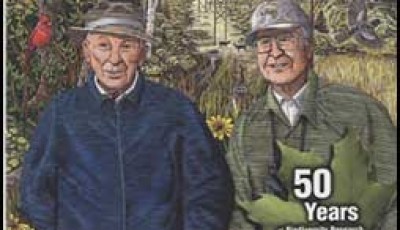History
Project Initiation
The Pennsylvania State Game Lands 33 (SGL 33) research project in central Pennsylvania began in 1953 in response to public concern about the impact of vegetation management practices on wildlife habitat within electric transmission rights-of-way (ROW). The research study was started in 1952 under the direction of:
- Hyland Johns, Asplundh Tree Expert LLC
- William Bramble, Professor of Forestry, Penn State
- W. R. Byrnes, Graduate Research Assistant, Penn State and, later, Professor of Forestry, Purdue University
- Roger Latham, Research Director, Pennsylvania Game Commission
- Arnie Carlson, Director of Research, DuPont
- Mark Fulton, Manager of Transmission, Penelec
Originally, the 3.5 miles of ROW was segmented into 6 vegetation treatments including mowing, basal low volume herbicide, and foliar herbicide among others. Over the 60-year study these treatments have been maintained with a variety of herbicide tank mixes and other chemicals as they became available. These initial treatment resulted in low density of incompatible trees and abundance of game wildlife including rabbits, grouse, and deer.

Drs. William Bramble (left) and W. R. Byrnes (right)
Border Zone Establishment
In 1982, the wire-border zone method of vegetation management was applied to the study area. This vegetation management approach produced a tree-resistant forb-shrub-grass cover type in the wire zone and a tall shrub cover in the border zone (pictured). This method increased wildlife habitat diversity on the ROW.

Wire-Border Zone Vegetation Management
Wildlife Research
In 1987, extensive studies of wildlife began on the ROW to include non-game species. These studies demonstrated that the wire-border zone management in the ROW provided habitat for native birds (especially early successional species), butterflies, herptofauna (amphibians and reptiles) and promoted diverse herbaceous species of plants (pictured).

Painted trillium (Trillium undulatum) in understory of border zone, May 2014 (Yahner, photo)
On-going Research
Today, SGL 33 is the site of the longest continuous study measuring the effects of herbicides and mechanical vegetation management practices on plant diversity, wildlife habitat, and wildlife use within a right-of-way (ROW). Similar studies have been conducted since 1987 at a companion site, Green Lane Research and Demonstration Area (GLR&D), in southeastern Pennsylvania since 1987. Both projects provide invaluable information for understanding the response of plants and animals to vegetation management on rights-of-way. The project currently is led by research partners from Penn State, Dow, Asplundh, and First Energy. In 2016, researchers began to study the effects of different vegetation management treatments on Hymenopteran (bees, wasps) pollinators (pictured).

Penn State Research Associate collects pollinators, May 2016 (Mahan, photo)